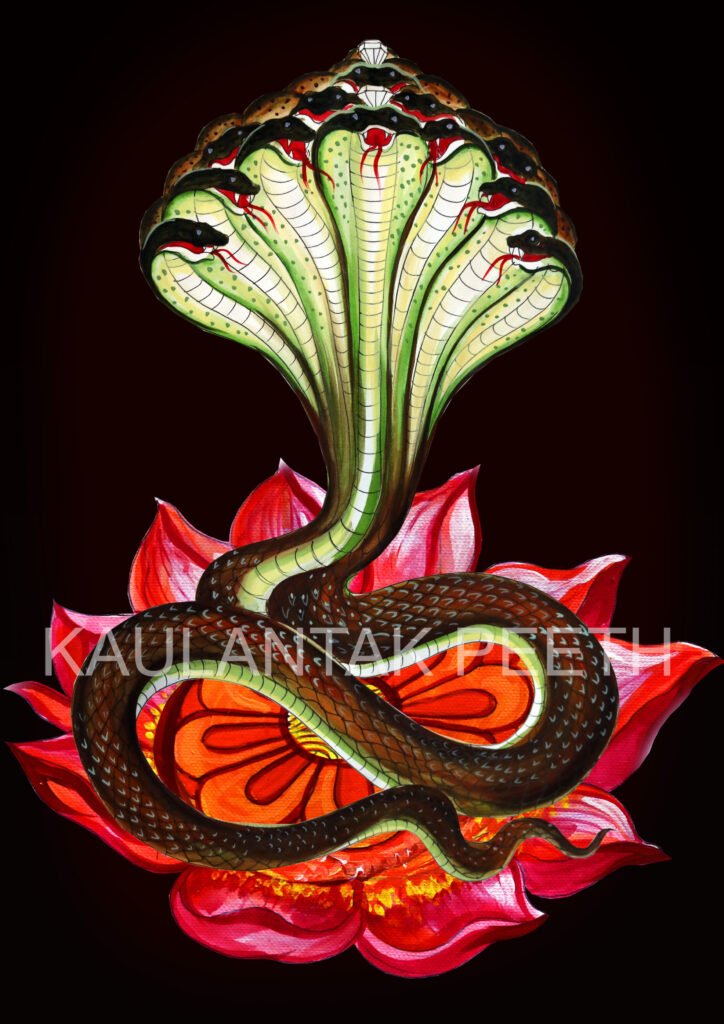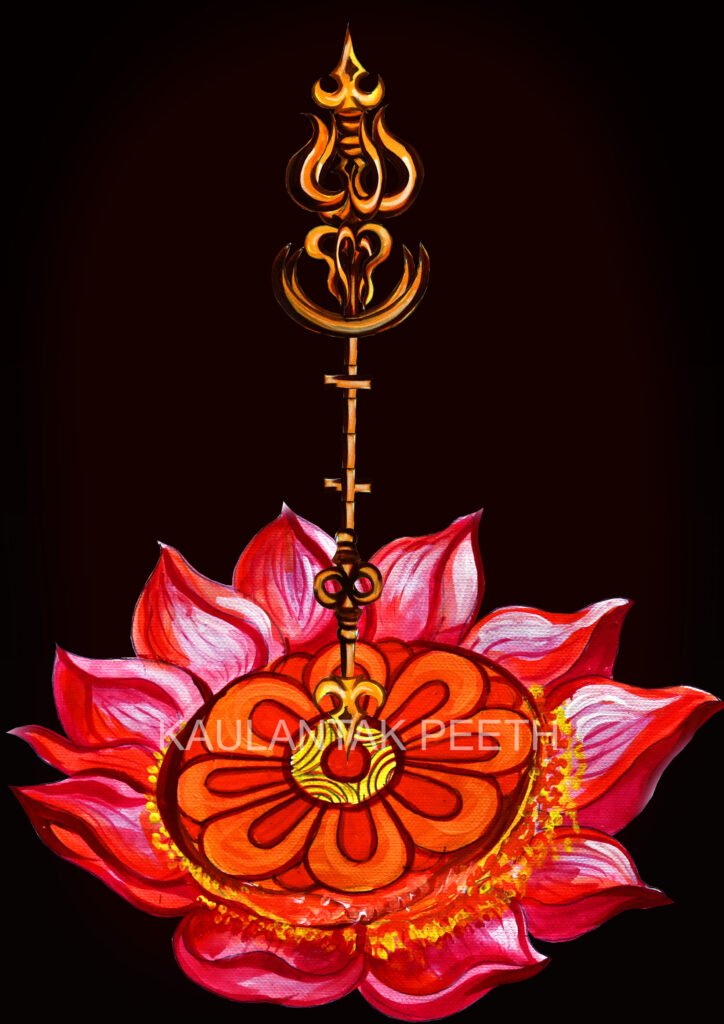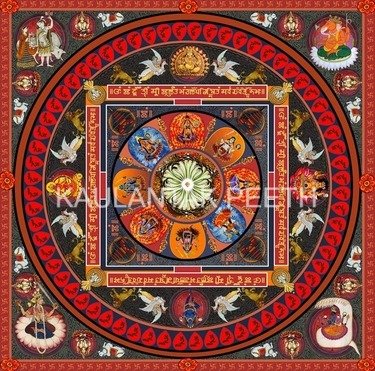Shyama Vartali Devi (Sanskrit: श्यामा वार्ताली), as per ‘Siddha Dharma’ is one of the four forms of goddess Vartali with Peet Vartali, Neel Vartali and Shyama Vartali. This form is also known as the black form of the goddess. It is the ‘tamas form’ of the Vartali goddess.
The ‘Siddha Dharma’ predominantly is a rajasic tradition but gives equal consideration for both the satwa and tamas tatwa too. It takes the some important aspects of both the tatwa and takes a middle path towards performing a sadhana. Therefore, the ‘Siddha Dharma’ worships her to cultivate some tatwas which are necessary for any sadhaka to be successful in their day to day life. For e.g. the worship worthy sage “Viswamitra” was jealous of Maharishi Vashist, he then out of his seer jealously performed sadhana perfected it and surpassed him. It is the pragmatic aspect of something that needs to be considered for its utility. Jealousy is not a good emotion but it was used by sage ‘Viswamitra’ rightly transforming it for his self development.
Etymology
Etymologically, the word श्यामा वार्ताली is a Sanskrit word (श्यामा वार्ताली = श्यामा + वार्ताली), which when translated gives the results as the combination of the two words Neel and Vartali (श्यामा + वार्ताली) which means ‘black’ and ‘Vartali. So, ‘Black Vartali’ is the tamas or black form of Vartali goddess.
According to ‘Siddha Dharma’, the ‘Black Vartali” goddess is a tantric deity. She is depicted as the goddess of ‘revolution’ and ‘impulsiveness. The ‘Siddha Dharma’ believes that she is the cocktail of (impulsiveness + wisdom). The black color is always the sign of tamas. The black color depicts the absence of fundamental features i.e the light for both humans and the universe as a whole. Even the ignorance is represented as a black color devoid of the light of the self. But ‘Siddha Dharma’ believes that before the formation of the universe there was only tamas and from tamas emerged a light and that light gave rise to the creation of this whole universe. Without tamas nothing can be created. For creation something has to be destroyed and from it new creation takes place.
The ‘Siddha Dharma’ being a rajasic Peeth only prescribes sadhaka some useful aspects of the goddess. The impulsiveness and the wisdom aspect are two things which needs to be cultivates inside every human. When nothing works in your favor, when people do not take you seriously, you need an impulse to transform yourself. That impulse gives you the courage to revolutionize your world and to achieve extraordinary feats. The same impulse transformed King ‘Kaushika’ to sage ‘Viswamitra’. That impulse if mixed with knowledge gives a person, the power to create ideologies that has lasting effect on society even after ones demise.
The ‘Siddha Dharma’ asserts that sadhana empowerment is recommended to be only received from a worthy guru with distinct guru/sishya lineage tradition. It is a waste of time if you try it on your own because empowerment or diksha means transfer of lineage power to the individual. Any sadhana of the caliber of Shyama Vartali should not be tried on your own as it might bring bad results.
Iconography
The ‘Siddha Dharma’ depicts her as one of form among the four forms of Vartali goddess. Being a tantric deity, she is richly depicted in symbols and colors. She is depicted as sitting on the ‘Yak skin’ on a lotus position or padmasana, she is depicted as having black complexion, beautiful and is also smiling with her lips not joined and her teeth lining can be seen. She is depicted as being ferocious, impulsive therefore normal householder, children and old age person are not recommended to her worship.
The ‘Siddha Dharma’ also depicts her with two big round breasts which don’t signify lust but motherly affection. When she is pleased, she treats her worshipper like her own children and protects them. Her whole body is adorned with ornaments made of gold. She wears a big golden crown on her head and in its centre is the maroon jem. She also is depicted wearing a big heavy necklace and a big golden garland. She also wears golden bangles in both her wrist. Her hair is scattered. She wears the garland of skulls.
‘Siddha Dharma’ depicts her as having eight hands, four in each side. She holds white lotus flower in one hand which signifies abundance while as in the another hand she is depicted as per ‘Siddha Dharma’ holding a trident which signifies her as the goddess of warriors. Her hand also holds a golden sickle which denotes that she can severe anyone. She also holds a sword in her hand which signifies her power to bestow the warrior traits to her sadhaka. She is depicted as holding a human skull signifying that her mind is in her control and she can direct her mind to do things as per her own discretion.
The Kaulantak Peeth has her own depiction and as per its own guru/sishya lineage. No images of Vartali are in public domain to the best of the knowledge of ‘Siddha Dharma’.
Modes of Worship
The Kaulantak Peeth tradition and the ‘Siddha Dharma’ primarily believe in the guru/sishya lineage because this helps to keep the knowledge free of any fallacies or arbitration. Since, the knowledge of goddess Vartali has passed down many generations from Lord Shiva to His Holiness, the ‘Siddha Dharma’ believes that to protect the sanctity of the sadhana, only guru/sishya lineage prescribed methods should be adopted and other methods be shunned.
The ‘Siddha Dharma’ prescribes many methods of her sadhana and worship methods from Yoga to pure Tantra. She is primarily a tantric deity, so the Peeth mainly prescribes the tantric methods but the Peeth is also eligible to impart it through the mode of Yoga because His Holiness Kaulantak Peethadhishwara “Mahayogi Satyendra Nath Ji Maharaj” (Ishaputra) is also adept in Yoga.
As mentioned before, Vartali goddess is the goddess of flowers. She loves flowers. She is very pleased by flowers. As per ‘Siddha Dharma’ the tantric pleases her through the offerings of various flowers. Her sadhana is to be done in solitude or in the midst of nature.
Besides that, the ‘Siddha Dharma’ can initiate a sadhaka into the sadhana path of Shyama Vartali from the below given methods and procedures. The decision shall rest upon His Holiness Kaulantak Peethadhishwara “Mahayogi Satyendra Nath Ji Maharaj” (Ishaputra) to initiate and impart the teachings to any sadhaka based on his own discretion. The methods and procedures are:
- Kaulachara
- Vedachara
- Mrikulachara
- Tantrokta
- Akulachara
- Mishrachara
- Shastrokta
- Aghorachara
- Vamachara
- Chinachara
- Samayachara
- Yoga Parampara
‘Siddha Dharma’ can also initiate the sadhaka through Yoga procedures. The Yoga procedure is all about using dharana/visualization to achieve the required perfection. The dharana procedure is only given through guru/sishya tradition and cannot be revealed in public as it is against the norms of the ‘Siddha Dharma’
Yantra
Yantra is the physical representation of any deity in geometrical form. The ‘Siddha Dharma’ uses geometric diagrams, words, syllable, symbols to manipulate the consciousness, so as it can be directed in a certain way to create an idea in the mind. Without Yantra, the tantric ritual of Shyama Vartali goddess is impossible. Yantra is the most important part of any tantric ritual.
As per ‘Siddha Dharma’, the ‘Shyama Vartali’ yantra uses triangles, circles and bhupura to create the Yantra.
Mantra
The ‘Kaulantak Peeth’ tradition of the siddha’s has numerous mantras of the goddess. The mantras of the goddess are also as per the modes of their worship. The mantra of Aghorachara is different than Misracharya, Kaulacharya with Akulacharya etc. Furthermore, the Peeth also recommends ‘Shabar Mantra’ for the sadhana procedure as it is very easy to comprehend and is understandable.
There might be lot of schools or modes of worship of the goddess but the Peeth and ‘Siddha Dharma’ prescribes four mantras for each deity for each mode of worship or kulas. For instance, a Aghora panth will prescribe four mantras for the “Shyama Vartali”. The four mantras represent four modes of nature. The four modes of nature or the gunas according to which the mantras corresponds are satwa, raja, tama and nirguna. The Peeth while imparting the diksha and mantra gives four mantras of a deity which is the satwa, raja, tama and nirguna mantra.
Scripture, Texts and eligibility
The Peeth and the ‘Siddha Dharma’ tradition have a special book called “Vartali devi sutram” which is maintained as in the form of oral tradition. The Guru gives the knowledge of the book through oral tradition.
“Vartali Devi Sutram” prescribes methods and percepts that one can cultivate in the daily habits of any individual so as to develop oneself. It prescribes short methods and standards to follow. It also mentions the fact that “Shyama Vartali” is the goddess of calm demeanor, so everyone is eligible to participate in her sadhana.
The Kaulantak Peeth is the Peeth of “veer bhava”, the ‘hero mentality”. So the goddess doesn’t believe in shortcuts. The ‘Siddha Dharma’ believes that to perfect her, strict discipline and perseverance is the key. When she is perfected, it is believed nothing lefts to be perfected.
Kaulantak Peeth and His Holiness Mahayogi Satyendra Nath Ji Maharaj
The Kaulantak Peeth is the oldest tradition of the lineage of the Kaula/Siddha lineage. It was created by lord Shiva for the betterment of human race so that the Siddhas of the Peeth could guide humans to their true nature and for the betterment of the path of Dharma. The Peeth out of many sects selects a Peethadhishwara to represent it. The Peethadhishwara is the elect of Gurumandala whose sole duty is to revive the spiritual wisdom and then prepare Siddhas.
The current head of Kaulantak Peeth is His Holiness “Mahayogi Satyendra Nath Ji Maharaj”(Ishaputra). He is the Gurumandala elect and in Kaliyuga he has descended from the Himalayas to impart the eternal wisdom of Himalaya to the selected Siddhas. “Kaulantak Peeth” believes that he is an avatara and it is a matter of great pride to us that we are being initiated into sadhana’s via His Holiness himself. Had it been any other yuga, it would have been a mere fantasy and next to impossible.
The ‘Siddha Dharma’ gives exclusive rights to His Holiness to do everything related to the sadhana as per his own discretion. Since, the norms of ‘Siddha Dharma’ are that the Guru is the nucleus; therefore everything has to revolve around the nucleus of His Holiness. But having said, he is also bounded by certain principles.
He can initiate anyone who is eligible for the sadhana, he who proves beyond reasonable doubt that they will help him to further his mission of preserving the timeless tradition of the ‘Siddha Dharma’ is taken into consideration. Just like being a Human is not necessary to be selected in the army, similarly to be initiated in the ‘Siddha Dharma’, a person has to be selected. The Peeth makes the final decision when it comes to imparting dikshas.





